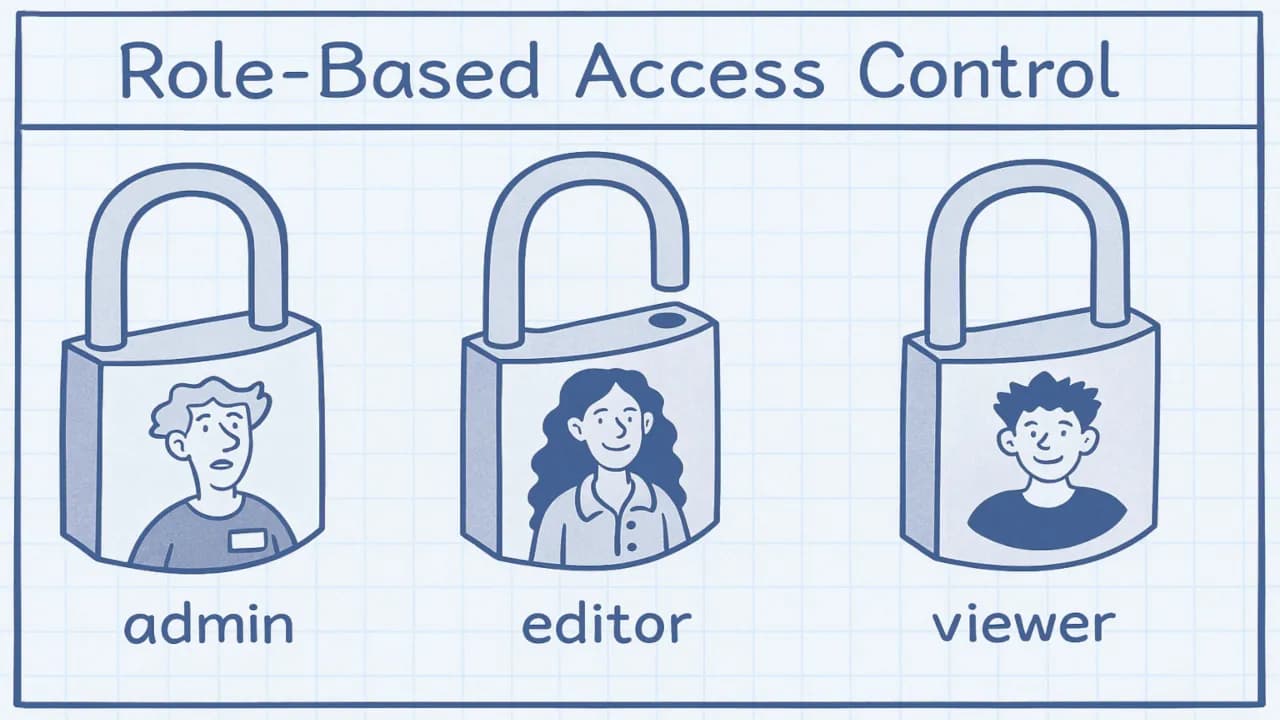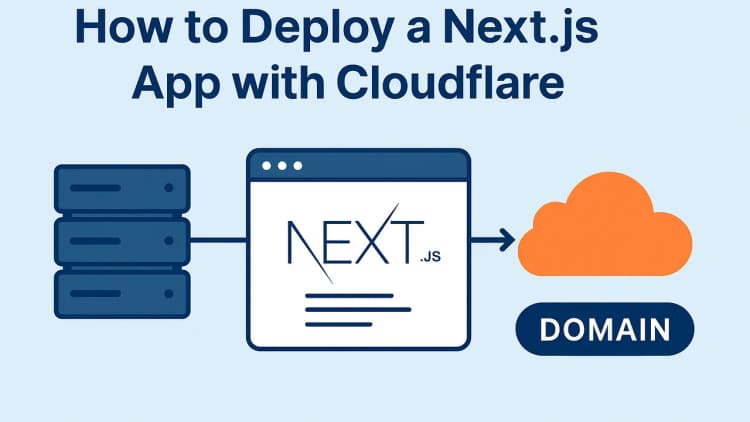Securing web applications is a top priority for developers, especially when managing resources like blog posts, website content, or user-submitted messages. Role-Based Access Control (RBAC) is a powerful security model that ensures users only perform actions they’re authorized for. In this detailed guide, we’ll explore what RBAC is, why it’s essential, and how to implement it in a Flask application using SQLite. You’ll get a fully functional demo that enforces RBAC for Create, Read, Update, and Delete (CRUD) operations on blog posts, website content, and contact messages, using a custom @RequirePermission decorator.
What is Role-Based Access Control (RBAC)?
RBAC is a security model that restricts system access based on roles assigned to users. Instead of granting permissions to individual users, RBAC associates permissions with roles, and users are assigned one or more roles. This approach simplifies permission management and enhances security.
Key Components of RBAC
- Users: Individuals interacting with the system (e.g., admins, editors, guests).
- Roles: Predefined groups with specific permissions (e.g., “admin,” “editor”).
- Permissions: Allowed actions (e.g., create, read, update, delete) on resources (e.g., blog posts, contact messages).
- Resources: Entities being protected, such as blog posts or website pages.
- Actions: Operations users can perform, typically Create, Read, Update, Delete (CRUD).
For example:
- An admin role might have full CRUD permissions on all resources.
- An editor role could create, read, and update blog posts but only read contact messages.
- A viewer role might have read-only access across all resources.
Why Use RBAC?
RBAC offers several benefits:
- Scalability: Managing permissions for roles is easier than for individual users.
- Security: Enforces the principle of least privilege, reducing unauthorized access risks.
- Flexibility: Roles can be reassigned or modified without system changes.
- Maintainability: Centralized permission management simplifies updates and audits.
RBAC is ideal for applications ranging from small blogs to enterprise systems, ensuring secure and manageable access control.
Building an RBAC-Powered Flask Application
Let’s create a Flask application that implements RBAC using SQLite to manage blog posts, website content, and contact messages. The app will use a @RequirePermission decorator to enforce permissions for CRUD operations and provide a RESTful API.
Prerequisites
To follow along, you’ll need:
- Python 3.6 or higher
-
Flask (
pip install flask) - Basic knowledge of Python, Flask, and SQLite
- A tool like Postman or cURL for testing API endpoints
Step 1: Setting Up the Flask Application
Our Flask app will:
- Use SQLite to store users, roles, permissions, and content.
-
Implement a
@RequirePermissiondecorator to check RBAC permissions. - Provide RESTful API endpoints for CRUD operations on blog posts, website content, and contact messages.
- Simulate user authentication (in production, use Flask-Login or JWT).
Here’s the complete Flask application code:
pythonimport sqlite3
from flask import Flask, jsonify, request, g
from functools import wraps
import uuid
app = Flask(__name__)
# SQLite database connection
def get_db():
db = getattr(g, '_database', None)
if db is None:
db = g._database = sqlite3.connect('rbac_demo.db')
db.row_factory = sqlite3.Row
return db
@app.teardown_appcontext
def close_connection(exception):
db = getattr(g, '_database', None)
if db is not None:
db.close()
# Initialize database tables
def init_db():
with app.app_context():
db = get_db()
db.executescript('''
CREATE TABLE IF NOT EXISTS users (
id TEXT PRIMARY KEY,
username TEXT UNIQUE NOT NULL
);
CREATE TABLE IF NOT EXISTS roles (
id TEXT PRIMARY KEY,
name TEXT UNIQUE NOT NULL
);
CREATE TABLE IF NOT EXISTS user_roles (
user_id TEXT,
role_id TEXT,
FOREIGN KEY (user_id) REFERENCES users(id),
FOREIGN KEY (role_id) REFERENCES roles(id),
PRIMARY KEY (user_id, role_id)
);
CREATE TABLE IF NOT EXISTS permissions (
role_id TEXT,
resource TEXT NOT NULL,
action TEXT NOT NULL,
FOREIGN KEY (role_id) REFERENCES roles(id),
PRIMARY KEY (role_id, resource, action)
);
CREATE TABLE IF NOT EXISTS blog (
id TEXT PRIMARY KEY,
title TEXT NOT NULL,
content TEXT NOT NULL
);
CREATE TABLE IF NOT EXISTS website (
id TEXT PRIMARY KEY,
page_name TEXT NOT NULL,
content TEXT NOT NULL
);
CREATE TABLE IF NOT EXISTS contact (
id TEXT PRIMARY KEY,
message TEXT NOT NULL
);
''')
# Insert sample data
cursor = db.cursor()
# Users
cursor.execute("INSERT OR IGNORE INTO users (id, username) VALUES (?, ?)", (str(uuid.uuid4()), "admin_user"))
cursor.execute("INSERT OR IGNORE INTO users (id, username) VALUES (?, ?)", (str(uuid.uuid4()), "editor_user"))
# Roles
cursor.execute("INSERT OR IGNORE INTO roles (id, name) VALUES (?, ?)", (str(uuid.uuid4()), "admin"))
cursor.execute("INSERT OR IGNORE INTO roles (id, name) VALUES (?, ?)", (str(uuid.uuid4()), "editor"))
# User-role assignments
admin_id = cursor.execute("SELECT id FROM users WHERE username = ?", ("admin_user",)).fetchone()[0]
editor_id = cursor.execute("SELECT id FROM users WHERE username = ?", ("editor_user",)).fetchone()[0]
admin_role_id = cursor.execute("SELECT id FROM roles WHERE name = ?", ("admin",)).fetchone()[0]
editor_role_id = cursor.execute("SELECT id FROM roles WHERE name = ?", ("editor",)).fetchone()[0]
cursor.execute("INSERT OR IGNORE INTO user_roles (user_id, role_id) VALUES (?, ?)", (admin_id, admin_role_id))
cursor.execute("INSERT OR IGNORE INTO user_roles (user_id, role_id) VALUES (?, ?)", (editor_id, editor_role_id))
# Permissions
cursor.execute("INSERT OR IGNORE INTO permissions (role_id, resource, action) VALUES (?, ?, ?)", (admin_role_id, "blog", "crud"))
cursor.execute("INSERT OR IGNORE INTO permissions (role_id, resource, action) VALUES (?, ?, ?)", (admin_role_id, "website", "crud"))
cursor.execute("INSERT OR IGNORE INTO permissions (role_id, resource, action) VALUES (?, ?, ?)", (admin_role_id, "contact", "crud"))
cursor.execute("INSERT OR IGNORE INTO permissions (role_id, resource, action) VALUES (?, ?, ?)", (editor_role_id, "blog", "cru"))
cursor.execute("INSERT OR IGNORE INTO permissions (role_id, resource, action) VALUES (?, ?, ?)", (editor_role_id, "website", "ru"))
cursor.execute("INSERT OR IGNORE INTO permissions (role_id, resource, action) VALUES (?, ?, ?)", (editor_role_id, "contact", "r"))
db.commit()
# RBAC permission check decorator
def RequirePermission(resource, actions):
def decorator(f):
@wraps(f)
def decorated_function(*args, **kwargs):
user = getattr(g, 'current_user', None)
if not user:
return jsonify({"error": "Unauthorized: No user logged in"}), 401
db = get_db()
cursor = db.cursor()
# Get user roles
cursor.execute('''
SELECT r.id, r.name FROM roles r
JOIN user_roles ur ON r.id = ur.role_id
WHERE ur.user_id = ?
''', (user['id'],))
roles = cursor.fetchall()
# Check required permissions
# Using a redis cache to store the permissions
# may be a better approach for performance on
# a production environment
for action in actions:
has_permission = False
for role in roles:
cursor.execute('''
SELECT action FROM permissions
WHERE role_id = ? AND resource = ? AND (action = ? OR action = 'crud')
''', (role['id'], resource, action))
if cursor.fetchone():
has_permission = True
break
if not has_permission:
return jsonify({"error": f"Permission denied for {resource} {action}"}), 403
return f(*args, **kwargs)
return decorated_function
return decorator
# Simulated logged-in user
@app.before_request
def set_current_user():
# In a real app, use JWT or Flask-Login for authentication
g.current_user = {"id": None, "username": "admin_user"}
if g.current_user['username']:
db = get_db()
cursor = db.cursor()
cursor.execute("SELECT id FROM users WHERE username = ?", (g.current_user['username'],))
user = cursor.fetchone()
if user:
g.current_user['id'] = user['id']
# Blog CRUD operations
@app.route('/blog', methods=['POST'])
@RequirePermission("blog", "c")
def create_blog():
data = request.get_json()
title = data.get('title')
content = data.get('content')
if not title or not content:
return jsonify({"error": "Title and content are required"}), 400
db = get_db()
cursor = db.cursor()
blog_id = str(uuid.uuid4())
cursor.execute("INSERT INTO blog (id, title, content) VALUES (?, ?, ?)", (blog_id, title, content))
db.commit()
return jsonify({"id": blog_id, "title": title, "content": content}), 201
@app.route('/blog/<id>', methods=['GET'])
@RequirePermission("blog", "r")
def read_blog(id):
db = get_db()
cursor = db.cursor()
cursor.execute("SELECT * FROM blog WHERE id = ?", (id,))
blog = cursor.fetchone()
if not blog:
return jsonify({"error": "Blog not found"}), 404
return jsonify({"id": blog['id'], "title": blog['title'], "content": blog['content']})
@app.route('/blog/<id>', methods=['PUT'])
@RequirePermission("blog", "u")
def update_blog(id):
data = request.get_json()
title = data.get('title')
content = data.get('content')
if not title or not content:
return jsonify({"error": "Title and content are required"}), 400
db = get_db()
cursor = db.cursor()
cursor.execute("UPDATE blog SET title = ?, content = ? WHERE id = ?", (title, content, id))
if cursor.rowcount == 0:
return jsonify({"error": "Blog not found"}), 404
db.commit()
return jsonify({"id": id, "title": title, "content": content})
@app.route('/blog/<id>', methods=['DELETE'])
@RequirePermission("blog", "d")
def delete_blog(id):
db = get_db()
cursor = db.cursor()
cursor.execute("DELETE FROM blog WHERE id = ?", (id,))
if cursor.rowcount == 0:
return jsonify({"error": "Blog not found"}), 404
db.commit()
return jsonify({"message": "Blog deleted"})
# Website CRUD operations
@app.route('/website', methods=['POST'])
@RequirePermission("website", "c")
def create_website():
data = request.get_json()
page_name = data.get('page_name')
content = data.get('content')
if not page_name or not content:
return jsonify({"error": "Page name and content are required"}), 400
db = get_db()
cursor = db.cursor()
page_id = str(uuid.uuid4())
cursor.execute("INSERT INTO website (id, page_name, content) VALUES (?, ?, ?)", (page_id, page_name, content))
db.commit()
return jsonify({"id": page_id, "page_name": page_name, "content": content}), 201
@app.route('/website/<id>', methods=['GET'])
@RequirePermission("website", "r")
def read_website(id):
db = get_db()
cursor = db.cursor()
cursor.execute("SELECT * FROM website WHERE id = ?", (id,))
page = cursor.fetchone()
if not page:
return jsonify({"error": "Page not found"}), 404
return jsonify({"id": page['id'], "page_name": page['page_name'], "content": page['content']})
@app.route('/website/<id>', methods=['PUT'])
@RequirePermission("website", "u")
def update_website(id):
data = request.get_json()
page_name = data.get('page_name')
content = data.get('content')
if not page_name or not content:
return jsonify({"error": "Page name and content are required"}), 400
db = get_db()
cursor = db.cursor()
cursor.execute("UPDATE website SET page_name = ?, content = ? WHERE id = ?", (page_name, content, id))
if cursor.rowcount == 0:
return jsonify({"error": "Page not found"}), 404
db.commit()
return jsonify({"id": id, "page_name": page_name, "content": content})
@app.route('/website/<id>', methods=['DELETE'])
@RequirePermission("website", "d")
def delete_website(id):
db = get_db()
cursor = db.cursor()
cursor.execute("DELETE FROM website WHERE id = ?", (id,))
if cursor.rowcount == 0:
return jsonify({"error": "Page not found"}), 404
db.commit()
return jsonify({"message": "Page deleted"})
# Contact CRUD operations
@app.route('/contact', methods=['POST'])
@RequirePermission("contact", "c")
def create_contact():
data = request.get_json()
message = data.get('message')
if not message:
return jsonify({"error": "Message is required"}), 400
db = get_db()
cursor = db.cursor()
contact_id = str(uuid.uuid4())
cursor.execute("INSERT INTO contact (id, message) VALUES (?, ?)", (contact_id, message))
db.commit()
return jsonify({"id": contact_id, "message": message}), 201
@app.route('/contact/<id>', methods=['GET'])
@RequirePermission("contact", "r")
def read_contact(id):
db = get_db()
cursor = db.cursor()
cursor.execute("SELECT * FROM contact WHERE id = ?", (id,))
contact = cursor.fetchone()
if not contact:
return jsonify({"error": "Contact message not found"}), 404
return jsonify({"id": contact['id'], "message": contact['message']})
@app.route('/contact/<id>', methods=['PUT'])
@RequirePermission("contact", "u")
def update_contact(id):
data = request.get_json()
message = data.get('message')
if not message:
return jsonify({"error": "Message is required"}), 400
db = get_db()
cursor = db.cursor()
cursor.execute("UPDATE contact SET message = ? WHERE id = ?", (message, id))
if cursor.rowcount == 0:
return jsonify({"error": "Contact message not found"}), 404
db.commit()
return jsonify({"id": id, "message": message})
@app.route('/contact/<id>', methods=['DELETE'])
@RequirePermission("contact", "d")
def delete_contact(id):
db = get_db()
cursor = db.cursor()
cursor.execute("DELETE FROM contact WHERE id = ?", (id,))
if cursor.rowcount == 0:
return jsonify({"error": "Contact message not found"}), 404
db.commit()
return jsonify({"message": "Contact message deleted"})
if __name__ == '__main__':
init_db()
app.run(debug=True)
Step 2: Understanding the Code Components
Let’s break down the key components of the Flask application to understand how RBAC is implemented.
Database Schema
The SQLite database includes five main tables:
- users: Stores user details (ID, username).
- roles: Defines roles like “admin” or “editor.”
- user_roles: Maps users to their roles (many-to-many relationship).
- permissions: Specifies which roles have which permissions for specific resources (e.g., “crud” for blog).
- blog, website, contact: Store content for each resource type.
The init_db() function initializes the database and adds sample data:
-
Users:
admin_userandeditor_user. -
Roles:
admin(full CRUD on all resources) andeditor(limited permissions). -
Permissions:
admin: Full CRUD (crud) on blog, website, and contact.editor: Create, read, update (cru) on blog; read, update (ru) on website; read-only (r) on contact.
RBAC Decorator
The @RequirePermission(resource, actions) decorator enforces RBAC by:
-
Retrieving the current user’s roles from the
user_rolestable. - Checking if any of the user’s roles have the required permissions for the specified resource and action (e.g., “blog” and “r” for reading).
-
Supporting a special
crudpermission that grants all CRUD actions, simplifying configuration for roles likeadmin. - Returning a 403 error if the user lacks permissions or a 401 error if no user is logged in.
Example usage:
python@RequirePermission("blog", "r")
def read_blog(id):
# Only accessible if the user has read permission for blog
API Endpoints
The application provides RESTful API endpoints for each resource:
-
Blog:
POST /blog,GET /blog/<id>,PUT /blog/<id>,DELETE /blog/<id> -
Website:
POST /website,GET /website/<id>,PUT /website/<id>,DELETE /website/<id> -
Contact:
POST /contact,GET /contact/<id>,PUT /contact/<id>,DELETE /contact/<id>
Each endpoint is protected by the @RequirePermission decorator, ensuring only authorized users can perform actions.
Simulated Authentication
For simplicity, the demo uses a hardcoded admin_user as the logged-in user. In a production environment, you’d integrate Flask-Login or JWT to dynamically set the g.current_user based on the authenticated user.
Step 3: Running the Application
To run the application:
-
Save the code in a file named
app.py. - Install Flask:
bashpip install flask
- Run the application:
bashpython app.py
-
The Flask development server will start at
http://127.0.0.1:5000.
Step 4: Testing the API
Use Postman or cURL to test the API endpoints. Here are some examples:
Create a Blog Post
bashcurl -X POST http://127.0.0.1:5000/blog \
-H "Content-Type: application/json" \
-H "Authorization: Bearer <token>" \
-d '{"title":"My First Post","content":"This is a test blog post."}'
Response (if the user has create permission for blog):
json{
"id": "uuid",
"title": "My First Post",
"content": "This is a test blog post."
}
Read a Blog Post
bashcurl http://127.0.0.1:5000/blog/<uuid> \
-H "Authorization: Bearer <token>"
Response:
json{
"id": "uuid",
"title": "My First Post",
"content": "This is a test blog post."
}
Test Permission Denial
If you change g.current_user to editor_user and try to delete a blog post (which requires d permission, not granted to the editor role):
bashcurl -X DELETE http://127.0.0.1:5000/blog/<uuid> \
-H "Authorization: Bearer <token>"
Response:
json{
"error": "Permission denied for blog d"
}
Step 5: Enhancing the Application
While this demo provides a solid foundation for RBAC in Flask, here are ways to improve it for production:
Add Caching for Performance
As you suggested, caching permissions could significantly improve performance, especially for frequent permission checks. You could use a caching solution like Redis or Flask-Caching to store user roles and permissions in memory, reducing database queries. For example:
-
Cache the user’s roles and permissions in Redis after the first query, using a key like
user:{user_id}:permissions. - Invalidate the cache when permissions are updated.
- Retrieve permissions from the cache for subsequent requests, falling back to the database if the cache is empty.
This approach minimizes database load and speeds up permission checks, which is crucial for high-traffic applications.
Implement Proper Authentication
Replace the simulated g.current_user with a real authentication system:
- Flask-Login: For session-based authentication.
- JWT: For token-based authentication, ideal for APIs.
- Integrate with OAuth2 or OpenID Connect for single sign-on (SSO).
Use an ORM
For larger applications, consider SQLAlchemy to simplify database interactions and improve maintainability. SQLAlchemy handles complex queries and relationships more elegantly than raw SQLite queries.
Add Input Validation
Enhance input validation to prevent issues like invalid data. Libraries like marshmallow or pydantic can validate JSON payloads effectively.
Expand Permission Granularity
The demo uses simple CRUD permissions, but you could support more granular permissions, such as:
- Read-only access to specific blog posts.
- Permissions based on content ownership (e.g., users can only edit their own posts).
- Conditional permissions based on resource attributes.
SEO Optimization Tips
To ensure this blog post ranks well on search engines, I’ve included:
- Relevant Keywords: Terms like “Flask RBAC,” “Role-Based Access Control Python,” “Flask SQLite tutorial,” and “RBAC permissions” are used naturally.
- Clear Headings: Hierarchical headings (H1, H2, H3) improve readability and help search engines understand the content structure.
- Code Snippets: Detailed code examples increase engagement by providing actionable content for developers.
- Actionable Content: Step-by-step instructions and testing examples encourage readers to try the demo, boosting dwell time.
- Call to Action: Encouraging comments or feedback improves user interaction metrics.
Conclusion
Implementing Role-Based Access Control in a Flask application with SQLite is a powerful way to secure your web application. The @RequirePermission decorator ensures that users only perform actions allowed by their roles, protecting resources like blog posts, website content, and contact messages. This demo provides a solid starting point for building secure, scalable applications.
To enhance the demo, consider adding caching (as you suggested), proper authentication, or an ORM like SQLAlchemy. Try running the code, testing the API endpoints, and experimenting with different permission scenarios.
Album of the day:




